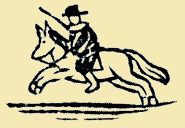“It is to act, to do, to perform.”
-- First Gravedigger, Hamlet
“No rehearsals, only performances.”
-- Shakespeare at Winedale founder
James “Doc” Ayres
The suggested activities in this section all work towards the goal of creating a working space in which this heightened quality of performance can flourish. We want the students to anticipate it, even demand it from one another.
Each of the activities works towards this goal by developing skills and awareness in one of four basic areas:
- Language
- Ensemble
- Play
- Story and character
We work along these four paths with the students, sometimes going down one path, then another; often the paths merge and intertwine.
The
language path is a gradual immersion in Shakespeare’s verse and prose. This takes time and can’t be rushed, and it’s best to work with very small pieces at first, building slowly. We want the students to eventually be fluent, and to understand exactly what they are saying.
Ensemble is what we must develop in order for our play or scene to succeed. This is the core idea behind student work in the UT Shakespeare at Winedale program. There are no stars at Winedale; we work to cultivate an energetic selflessness. The whole must be greater than the sum of the parts for our performance to be remarkable. So we work on teambuilding exercises and games and emphasize a democratic spirit.
Play is the key to how we explore a play. We must go at it with the same gusto we have when we young and playing on the playground. This kind of play is a mixture of a wonderfully intense game and a focused session of make-believe, with rules – the rules being the words. As Dr. Ayres reminds us, to perform rather than rehearse means to give it our all each time, and to never just walk through the play. (It’s like the sign hanging over the UT Longhorn football practice field: “Practice Winning Every Day.”) Actors in Shakespeare’s time were called players – like them, we must “play the play”. We may assume that kids are already experts at playing, but often, when they step onto a stage, they clam up. So we work on the playfulness and fearlessness needed to be open and “in the moment” in performance.
Story and character lead us into a place where, as Hamlet put it, the play holds “the mirror up to nature.” We are introduced to compelling, human stories, which touch us even in their most absurd comic moments; and we come to see these characters as old friends, almost as extra members of the class. The stories are new and thrilling and funny to the kids; it’s a delight to be the storyteller yourself, and to be the first one to share with them what happens in one of these great plays.
We want the students to be strong in each of these areas.
In the next section, you will be able to read descriptions of some of our favorite activities to do with classes. As you’ll see, most of them work on each of these four areas in some way.


